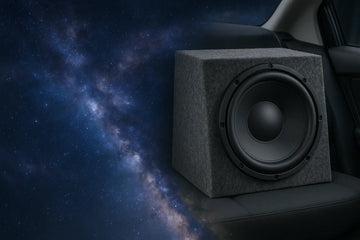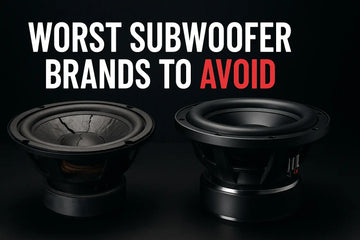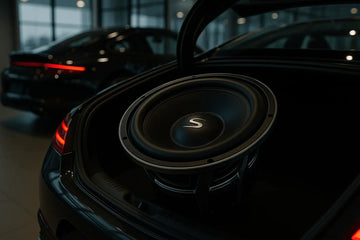Ultimate Guide: Tuning Subwoofers for Car Audio Excellence
Master the art of subwoofer tuning with interactive tools, expert techniques, and step-by-step guidance
Understanding Subwoofer Tuning Fundamentals
Why Proper Tuning Matters
Subwoofer tuning is the difference between muddy, overwhelming bass and tight, musical low-frequency reproduction. Proper tuning ensures your subwoofer integrates seamlessly with your main speakers, providing enhanced musicality rather than just loud bass.
Key Tuning Parameters
5-Minute Quick Start Guide
Get Your Subwoofer Dialed In Fast
Follow these steps for immediate improvement. Fine-tune later with our advanced tools below.
Set Crossover
Start with 80Hz crossover frequency. This works for most systems and vehicle types.
Adjust Gain
Set gain to minimum, play familiar music, slowly increase until bass balances with mids/highs.
Check Phase
Try both 0° and 180° phase settings. Choose the setting that sounds fuller and tighter.
Interactive Tuning Calculators
Crossover Frequency Calculator
Input your vehicle and speaker specifications to get optimal crossover recommendations.
Vehicle Information
Recommended Settings
Amplifier Gain Setting Wizard
Follow this step-by-step process to set your amplifier gain correctly without distortion.
Set Initial Levels
Turn subwoofer gain to minimum (counterclockwise). Set head unit volume to 3/4 maximum.
Play Test Track
Use a track with consistent, moderate bass content (not heavy bass music).
"Hotel California" - Eagles
"Come As You Are" - Nirvana
"Take Five" - Dave Brubeck
Gradually Increase Gain
Slowly turn the gain clockwise until you hear the bass clearly, then continue until it balances with your main speakers.
Fine-Tune Balance
Play various music styles and adjust gain slightly for best overall balance.
Phase Alignment Tool
Determine the correct phase setting for your subwoofer installation.
Phase Test Procedure
What to Listen For:
- Fuller, more impactful bass
- Better integration with main speakers
- Tighter, more controlled low end
- Avoid thin or hollow-sounding bass
Phase Setting Guide
0° Phase (Normal)
Best when subwoofer is close to main speakers or in front of listening position.
180° Phase (Inverted)
Often better when subwoofer is far from mains or behind listening position.
Vehicle-Specific Tuning Presets
Sedan
SUV/Crossover
Truck/Pickup
Coupe/Hatchback
Universal Tuning Tips by Vehicle Type
Large Vehicles (SUV, Truck)
- Lower crossover frequencies (70-90Hz)
- May need more gain due to cabin size
- Consider multiple subwoofers
- Phase often needs to be 180°
Compact Vehicles (Sedan, Coupe)
- Higher crossover frequencies (80-110Hz)
- Less gain needed due to small space
- Phase typically 0° but test both
- Focus on tight, controlled bass
Advanced Tuning Techniques
Acoustic Room Correction
Advanced techniques to compensate for your vehicle's acoustic properties.
Standing Wave Management
Identify and minimize problematic frequency buildup in your vehicle's cabin.
EQ Compensation
Use parametric EQ to address specific frequency issues.
Multiple Sub Integration
Optimize multiple subwoofer installations for even response.
Time Alignment and Delay
Understanding Time Alignment
Time alignment ensures all speakers arrive at your ears simultaneously, creating a cohesive soundstage.
Distance-Based Delay Calculation
For every foot of distance difference, add 0.9ms of delay to the closer speaker.
Measurement Process:
- 1. Measure distance from each speaker to your ears
- 2. Calculate difference in distances
- 3. Apply delay to closer speakers
- 4. Fine-tune by ear with test tones
Subwoofer Delay Settings
Typically needs 5-15ms delay depending on vehicle size
Usually requires 0-5ms delay
Measure and calculate for optimal results
DSP Integration for Perfect Bass
Digital Signal Processing takes subwoofer tuning to the next level with precise control over every parameter.
DSP Advantages for Subwoofers
-
Precise Crossover Control: Exact frequency selection with multiple slope options
-
Parametric EQ: Target specific frequency issues with surgical precision
-
Time Alignment: Perfect phase and timing integration
-
Multiple Presets: Different tuning for various music styles
Recommended DSP Settings
Rock/Pop Tuning
• EQ: Slight boost at 40-50Hz
• Compression: Light, to control dynamics
Hip-Hop/Electronic
• EQ: Enhanced 30-40Hz for sub-bass
• Limiter: Protect against excessive levels
Classical/Jazz
• EQ: Flat response, minimal processing
• Dynamics: Preserve natural dynamics
Professional DSP Tuning Process
Measure
Use RTA to analyze current response
Identify
Find peaks, nulls, and problem areas
Correct
Apply targeted EQ and timing adjustments
Verify
Listen test with various music
Troubleshooting Common Issues
Quick Problem Diagnosis
🔊 Muddy, Unclear Bass
• Crossover frequency too high
• Gain set too high
• Poor enclosure design
Solutions: Lower crossover to 70-80Hz, reduce gain, check phase setting
🔇 Weak, Absent Bass
• Gain too low
• Wrong phase setting
• Crossover frequency too low
Solutions: Increase gain gradually, try opposite phase, raise crossover
⚡ Distorted Bass
• Amplifier clipping
• Subwoofer overdriven
• Poor quality source material
Solutions: Reduce gain, check amp power rating, use high-quality tracks
🎵 Uneven Bass Response
• Room modes/standing waves
• Poor subwoofer placement
• Multiple subs out of phase
Solutions: Try different placement, use EQ, check sub wiring
Interactive Troubleshooter
Answer a few questions to get personalized solutions:
What's the primary issue you're experiencing?
Advanced Troubleshooting Techniques
Using Test Tones
Polarity Testing
Frequency Response Analysis
Recommended Audio Intensity Products
Complete Subwoofer System Packages
Perfectly matched components for optimal performance and easy tuning.
Entry Level System
Professional System
Ultimate System
Individual Components for Custom Builds
Premium Subwoofers
Monoblock Amplifiers
Custom Enclosures
DSP Processors
Professional Installation Services
Why Choose Professional Installation?
- Optimal placement for your specific vehicle
- Professional wiring and safety standards
- Expert tuning and calibration
- Warranty protection and support
Installation Packages
Frequently Asked Questions
What's the best crossover frequency for my subwoofer?
The optimal crossover frequency depends on your main speakers' capabilities. For most factory systems, start with 80Hz. If your main speakers can handle lower frequencies well (6.5" or larger), try 70Hz. For smaller speakers (5.25" or less), consider 90-100Hz. The goal is seamless integration without overlap or gaps.
How do I know if my subwoofer phase is set correctly?
Play music with consistent bass content and switch between 0° and 180° phase settings. The correct setting will sound fuller, tighter, and more integrated with your main speakers. If you hear hollow or thin bass, try the opposite phase setting. The difference is usually immediately apparent.
Why does my bass sound muddy and unclear?
Muddy bass typically results from three issues: crossover frequency set too high (allowing subwoofer to play midrange frequencies), gain set too high (causing distortion), or incorrect phase alignment. Start by lowering the crossover to 70-80Hz, reduce gain, and verify phase setting.
Can I use multiple subwoofers in my car?
Yes, multiple subwoofers can provide more even bass response and higher output. However, proper installation is crucial - they must be wired correctly (matching impedance), placed optimally to avoid cancellation, and individually adjustable for level and phase. Consider professional installation for multi-sub systems.
Do I need a DSP for good subwoofer performance?
While not absolutely necessary, a DSP significantly improves subwoofer integration and allows precise tuning impossible with analog controls. DSP benefits include exact crossover frequencies, parametric EQ for room correction, time alignment, and multiple presets. For serious enthusiasts, DSP is highly recommended.
How much power does my subwoofer really need?
Most subwoofers perform well with 50-75% of their RMS power rating. A 500W RMS subwoofer will usually sound excellent with a 300-400W amplifier. Overpowering is less damaging than underpowering with a clipping amplifier. Focus on clean, undistorted power rather than maximum wattage.
Get Advanced Tuning Tips
Join our newsletter for expert car audio tips, product updates, and exclusive tuning guides.
No spam, unsubscribe anytime. Get tips from car audio professionals.





